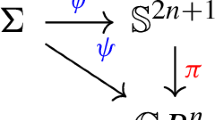Abstract
We obtain upper and lower bounds for Steklov eigenvalues of submanifolds with prescribed boundary in Euclidean space. A very general upper bound is proved, which depends only on the geometry of the fixed boundary and on the measure of the interior. Sharp lower bounds are given for hypersurfaces of revolution with connected boundary: We prove that each eigenvalue is uniquely minimized by the ball. We also observe that each surface of revolution with connected boundary is Steklov isospectral to the disk.


Similar content being viewed by others
References
Berger, M., Gauduchon, P., Mazet, E.: Le spectre d’une variété riemannienne. Lecture Notes in Mathematics, vol. 194. Springer, Berlin (1971)
Cianci, D., Girouard, A.: Large spectral gaps for Steklov eigenvalues under volume constraints and under localized conformal deformations. Ann. Global Anal. Geom. (to appear)
Colbois, B.: The spectrum of the Laplacian: a geometric approach. In: Geometric and Computational Spectral Theory, Volume 700 of Contemporary Mathematics, pp. 1–40. American Mathematical Society, Providence (2017)
Colbois, B., Maerten, D.: Eigenvalues estimate for the Neumann problem of a bounded domain. J. Geom. Anal. 18(4), 1022–1032 (2008)
Colbois, B., Dryden, E.B., El Soufi, A.: Bounding the eigenvalues of the Laplace–Beltrami operator on compact submanifolds. Bull. Lond. Math. Soc. 42(1), 96–108 (2010)
Colbois, B., El Soufi, A., Girouard, A.: Isoperimetric control of the Steklov spectrum. J. Funct. Anal. 261(5), 1384–1399 (2011)
Colbois, B., El Soufi, A., Girouard, A.: Isoperimetric control of the spectrum of a compact hypersurface. J. Reine Angew. Math. 683, 49–65 (2013)
Colbois, B., Girouard, A., Raveendran, B.: The Steklov spectrum and coarse discretizations of manifolds with boundary (2016). arXiv:1612.07665
Colbois, B., El Soufi, A., Girouard, A.: Compact manifolds with fixed boundary and large Steklov eigenvalues (2017). arXiv:1701.04125
Dodziuk, J.: Eigenvalues of the Laplacian on forms. Proc. Am. Math. Soc. 85(3), 437–443 (1982)
Escobar, J.F.: The geometry of the first non-zero Stekloff eigenvalue. J. Funct. Anal. 150(2), 544–556 (1997)
Fraser, A., Schoen, R.: The first Steklov eigenvalue, conformal geometry, and minimal surfaces. Adv. Math. 226(5), 4011–4030 (2011)
Girouard, A., Polterovich, I.: Upper bounds for Steklov eigenvalues on surfaces. Electron. Res. Announc. Math. Sci. 19, 77–85 (2012)
Girouard, A., Polterovich, I.: Spectral geometry of the Steklov problem (survey article). J. Spectr. Theory 7(2), 321–359 (2017)
Girouard, A., Parnovski, L., Polterovich, I., Sher, D.A.: The Steklov spectrum of surfaces: asymptotics and invariants. Math. Proc. Camb. Philos. Soc. 157(3), 379–389 (2014)
Hassannezhad, A., Miclo, L.: Higher order Cheeger inequalities for Steklov eigenvalues. Ann. Sci. École Norm. Sup (to appear)
Ilias, S., Makhoul, O.: A Reilly inequality for the first Steklov eigenvalue. Differ. Geom. Appl. 29(5), 699–708 (2011)
Jammes, P.: Une inégalité de Cheeger pour le spectre de Steklov. Ann. Inst. Fourier (Grenoble) 65(3), 1381–1385 (2015)
Montaño, O.A.: The Stekloff problem for rotationally invariant metrics on the ball. Revista Colombiana de Matemáticas 47(2), 181–190 (2013)
Provenzano, L., Stubbe, J.: Weyl-type bounds for Steklov eigenvalues. J. Spectr. Theory (to appear)
Yang, L., Yu, C.: A higher dimensional generalization of Hersch–Payne–Schiffer inequality for Steklov eigenvalues. J. Funct. Anal. 272(10), 4122–4130 (2017)
Acknowledgements
We thank one of the anonymous referees for suggesting an elegant proof to Proposition 1.10. We thank another referee for carefully reading the paper and suggesting several improvements, in particular regarding Theorem 1.11. While a postdoctoral student at the Université de Neuchâtel, KG was supported by the Swiss National Science Foundation Grant No. 200021_163228 entitled Geometric Spectral Theory. KG also acknowledges support from the Max Planck Institute for Mathematics, Bonn. AG acknowledges support from the NSERC Discovery Grants Program.
Author information
Authors and Affiliations
Corresponding author
Appendix: Surfaces of Revolution with Connected Boundary are Steklov Isospectral
Appendix: Surfaces of Revolution with Connected Boundary are Steklov Isospectral
The goal of this appendix is to prove Proposition 1.10.
Let \(M\subset \mathbb R^3\) be a surface of revolution with connected boundary \(\partial M=\mathbb S^1\subset \mathbb R^2\times \{0\}\) and induced Riemannian metric g. We will construct a smooth function \(\delta :M\rightarrow (0,\infty )\) such that \(\delta \bigl |\bigr ._{\partial M}=1\) and \((M,\delta g)\) is isometric to the Euclidean unit disk \(({\mathbb {D}},g_0)\).
The Riemannian metric on M can be written as \(g=dr^2+h(r)^2d\theta ^2\) on \([0,L)\times \mathbb S^1\), where \(d\theta \) is the usual metric on \(\mathbb S^1\) and, as in Sect. 3.1, the function h satisfies \(h(0)=1\) and \(h(L)=0\). Define the diffeomorphism \(\tau :[0,L)\rightarrow [0,\infty )\) by
The map \(\Phi :(0,L)\times \mathbb S^1\rightarrow (0,1)\times \mathbb S^1\) defined by
induces a conformal diffeomorphism to the disk \({\mathbb {D}}\) represented by the metric \(g_0=dr^2+(1-r)^2d\theta ^2\) on \([0,1)\times \mathbb S^1\). In particular, one has \(\Phi ^\star (g_0)=\delta g\), where the conformal factor \(\delta \in C^\infty (M)\) is given by
Moreover \(\delta \bigl |\bigr ._{\partial M}=1\), since \(\delta (0,\theta )=1\). This implies that (M, g) and \((M,\delta g)\cong ({\mathbb {D}},g_0)\) are Steklov isospectral.
Rights and permissions
About this article
Cite this article
Colbois, B., Girouard, A. & Gittins, K. Steklov Eigenvalues of Submanifolds with Prescribed Boundary in Euclidean Space. J Geom Anal 29, 1811–1834 (2019). https://doi.org/10.1007/s12220-018-0063-x
Received:
Published:
Issue Date:
DOI: https://doi.org/10.1007/s12220-018-0063-x



